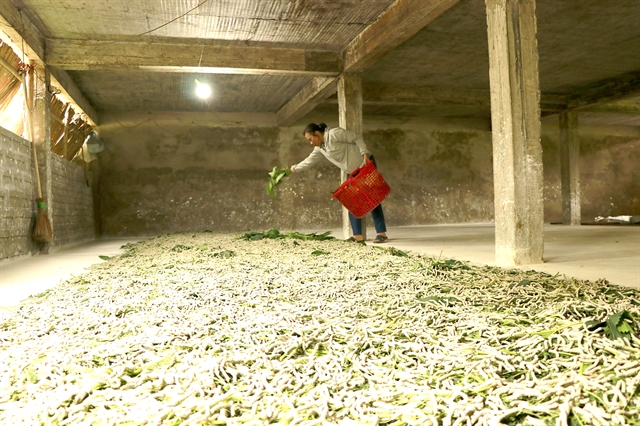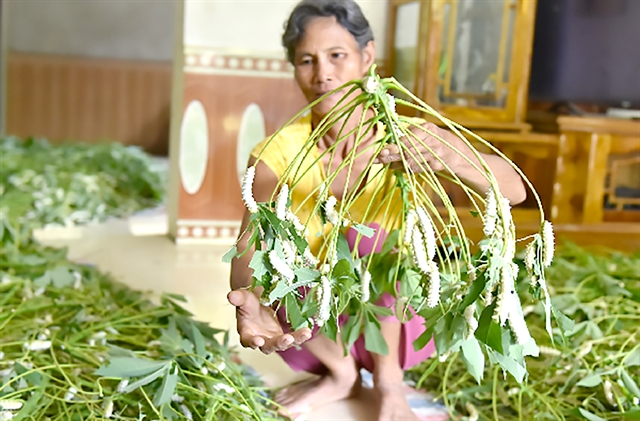 Society
Society

 |
| A floor worm farm in Yên Bái Province. — Photo yenbai.gov.vn |
YÊN BÁI — Farming silkworms on the floor is a practice that was recently tested as a potential alternative for the traditional method of raising the worms on bamboo trays – but after a trial, the model has been dropped in two out of three areas.
Among the three communes that had tested this silkworm model, only Việt Thanh in the Trấn Yên District of the mountainous northern Yến Bái Province is still holding on.
Meanwhile, Ngọc Lũ Commune in Hà Nam Province and Nam Thắng Commune in Nam Định Province, both in the northern delta region, no longer have silkworms.
Lê Hồng Vân, director of the Central Mulberry Research Centre, said that raising silkworms on the ground requires a separate breeding house and a large floor area, which are very difficult to find in the crowded northern delta region.
Normally, traditional houses in the area have altars in the middle and two bedrooms on either side of the home. For ground silkworm farming to work, people had to remove all of their furniture, including beds, cabinets, tables and chairs, to make space, living instead in small rooms in the house.
This made their lives uncomfortable during a small pilot programme to test out the silkworm farming method.
After a short trial period with a good evaluation, people put their belongings back in their houses and returned to the traditional method of raising silkworms on bamboo trays.
Vân said the new method of raising silkworms on the floor is more suitable for regions where people have big houses with more space available for farming.
That's why only Việt Thanh Commune in the northern mountainous province of Yên Bái found the model to be a success, Vân said.
Now the silkworm farming method is very popular in the province.
Raising silkworms on the ground actually makes things simpler. People no longer have to catch the silkworms to put them on bamboo trays when they're ready to spin their cocoons. With the new method, when the silkworms are ready, farmers can arrange them in a row and then place trays so the worms can crawl up on their own. This helps breeders save time and labour.
In the northern plains region, it is impossible to clean and disinfect the silkworms' area, because people are living in the same houses.
But in Yên Bái Province, silkworms are raised in separate areas, so they can be regularly cleaned with disinfectant.
Breeders can also sprinkle white lime on the silkworms every day to both disinfect and dry the farming area.
As for the worms' favourite food, mulberry leaves, farmers have been growing newer hybrid varieties that yield more leaves than ever.
Before the 1970s, farmers grew an indigenous variety of mulberry, with a yield of only 12-15 tonnes of leaves per hectare. The new hybrid varieties have been around since 1993, and can achieve a yield of 30-35 tonnes of leaves per hectare. Currently, new mulberry varieties account for over 90 per cent of all mulberry plants grown.
Meanwhile, a change in silkworm breeding saw a shift from indigenous silkworms with yellow cocoons and very thin shells to a hybrid variety, changing from worms with yellow cocoons to those with white cocoons from China.
The shift was triggered by a recession that caused the breeding situation in the country to stagger in 1993 and eventually collapse following the Silkworm Corporation’s going bankrupt.
Dozens of silkworm farms throughout the country – including in the northern delta as well as more mountainous areas like Mộc Châu District in Sơn La Province and the Bà Nà area in Đà Nẵng City – were all sold off.
In these ‘chaotic’ times, private traders then started importing silkworm eggs from China, resulting in an influx of worms with white cocoons.
Indigenous varieties, including silkworms with yellow cocoons and cassava silkworms, eventually accounted for up to 20 per cent of the market share.
By 2012, the mulberry growing area had begun to increase again. It currently sits at nearly 14,000 hectares, double the size it was during the lowest growing period but still less than half of the peak mulberry growing area.
However, cocoon output is now more than 16,800 tonnes, no less than it was during the peak period.
Silk output of Việt Nam in 2021 reached 1,067 tonnes, ranking fourth in the world with export turnover of US$72 million, after China, India and Uzbekistan – even higher than it was during the height of the silk boom in the 90s.
While many countries are still seeing a decline in mulberry growing area, Việt Nam has increased the fastest in the rankings, while Thailand, which previously had a massive mulberry growing area, has not yet overcome its decline.
Silk reeling factories in Việt Nam have also shifted to automatic technology that allows for much higher productivity and higher quality of silk.
Villages raise silkworms for food
 |
| Raising cassava silkworms for food in Phú Thọ Province. — Photo nongnghiep.vn |
According to Vân, in the past, people raised silkworms mainly for silk production, but now the practice is multi-purpose.
Silkworms are vulnerable to chemicals, and so are the mulberry leaves they eat, not any type of pesticide can be used on these plants. So silkworm are a naturally safe food, suitable for future food trends including adopting a more nutrient-rich, insect-based diet, the expert remarked.
Vietnamese people typically eat pupae. The cocoons are stored in a cold container so breeders can sell the pupae as food and help silk breeders increase their revenue.
Meanwhile, people in other countries do not usually eat the pupae, so when making silk they dry the cocoons, reel the silk and then process the pupae into animal feed.
During a period of market fluctuations when silk could not be sold, farmers had to sell the silkworms themselves or cut cocoons to sell the pupae. That's why in Việt Nam, a market for raising silkworms and selling pupae as food has gradually formed in traditional silkworm farming areas.
For example, Hồng Phong Commune in the Vũ Thư District of Thái Bình Province has about 250ha of mulberry plants specifically used to raise silkworms for pupae.
Although the yield is only 5-6kg of cocoon for each egg cycle, with an average selling price of VNĐ100,000 (US$25) per kilo of cocoon, raising silkworms this way is still quite economically efficient.
Thái Bình, Bắc Giang, and Bắc Ninh provinces also have several dozens of hectares for mulberry cultivation, to raise silkworms for pupae.
Because mulberry is a crop with just one use, the mulberry growing area can give estimates as to the yield of silkworms and silk.
But cassava is a root crop, and only in some places are the leaves used to raise silkworms. This means it is impossible to estimate the silk output from the crop itself.
Cassava silkworm yields can only be estimated through the number of eggs.
Raising cassava silkworms is useful for farmers because the farmer can take advantage of available cassava farming areas, using less than one third of the leaves for silkworms so as not to affect the roots below.
These types of silkworms are also very popular as food.
There is currently a village producing cassava silkworms for food in Đồng Lương Commune in Phú Thọ Province.
Vi Tiến Cường, chairman of the Đồng Lương Commune People's Committee, said that in the past, the local people mainly planted eucalyptus in the area, which has a five-year cycle, and sold nearly VNĐ100 million ($3,900) per hectare, equivalent to less than VNĐ20 million ($780) per hectare per year.
Since people converted to growing cassava for leaves to feed silkworms, the harvest is VNĐ200 million ($7,800) per ha per year, up to 10 times the profits from growing eucalyptus, Cường said.
After the first year of picking leaves, people cut off the cassava stem, leaving the root to sprout more leaves. At the end of the second year, they dig up the tubers to sell as animal feed, he explained.
It is estimated that the whole commune currently has about 300 workers involved in raising cassava silkworms for food and silk, providing most of the breeds for the whole northern region, and bringing in an annual revenue of up to VNĐ60 billion ($2.4 million), he said. — VNS